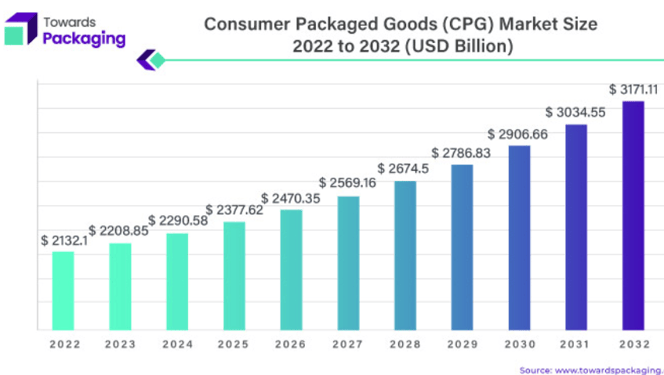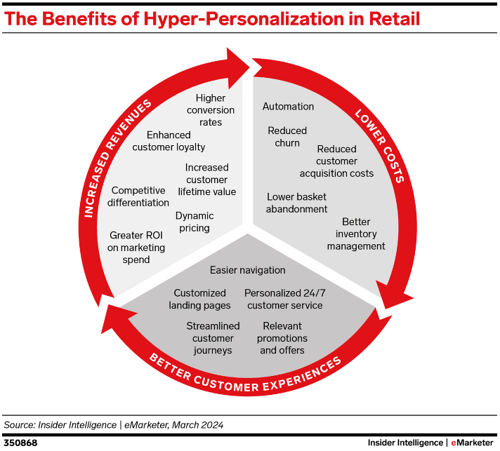First, I want to congratulate both Dr. Russell Zwanka and Western Michigan University for putting together such a successful conference. From the keynote speakers and panel discussions to the amazing students that showed up to support the Food Marketing Program, the 2024 Food Marketing Conference was truly a top-tier experience. Following up on our recent blog about contextual commerce, I wanted to share a few of my thoughts on the main themes of the conference as they relate to one larger overall theme: the rise in hyper-personalization in retail.
Hyper-personalization is a marketing strategy powered by data, analytics and AI, providing marketers with the insights and capabilities necessary to adapt to individual customers in real time. Examples of this include Starbucks using AI to craft custom messages to audiences in their apps, Amazon creating hyper-personalized homepages with relevant product recommendations and more.
So what are the factors driving the rise of hyper-personalization and its viability as a successful marketing strategy? Let’s dive in.
One theme you could not escape throughout the conference was data – and for good reason. The amount of consumer-preference data available today is truly outstanding. With “nearly 90% of grocery sales still occurring in physical stores,” point-of-sale retail data still reigns supreme when it comes to sources for most category demand managers.
One of my favorite aspects of this modern-age of retail data is the rise of new data companies. I had a chance to listen to Kathryn Peters, Head of Industry Relations for SPINS, during a “Health and Nutrition Panel” about the creation of SPINS and the elevated insights we can derive from retail data today. SPINS is headquartered in Chicago and connects shopper values to product innovation by combining POS data across the conventional, ecommerce and natural channels with deep product knowledge.

The power of harnessing such data cannot be overstated. For example, data we collected for one of our clients, Certified Angus Beef, showed its audience had a glaring lack of knowledge about how to cook a roast. As a result, we created an app that encouraged and assisted people in mastering the art of roasting.
The volume of data we have today, along with the ability to co-mingle and enrich that information, has led to a world where hyper-personalization is possible. Additionally, in a North American consumer packaged goods market valued at more than $2 trillion, it leaves a lot of room for even more innovation and growth in consumer data and category demand. I’ll continue to have my eyes on new companies as they emerge, so we at Hart can keep our clients on the cutting edge of retail insights.
Another factor fueling the use of hyper-personalization is the rise of big data analytics, AI and machine learning. This is a good precursor to discuss as we dive into more complete retail data systems like Grocery Shopii. Big data analytics for retail management is only made possible through machine learning and artificial intelligence. These two technologies have allowed the accelerated growth of data processing and expanded the depths of insights we can create today. To say the volume of data points we have is overwhelming is an absolute understatement and these two technologies are the primary ways in which processing the data is possible.
For a real-world example, let’s take a look at Katie Hotze, CEO and founder of Grocery Shopii, who held an early discussion at the conference on contextual commerce and later moderated the inspiring “Technology and Innovation Panel.” If you do not know about Grocery Shopii, I would encourage you to take a look – it's a fascinating concept. Katie and her company have harnessed the power of content, meal planning and recipe suggestions to boost customer engagement as well as in-store and online sales, all while emphasizing the sale of private-label products. She took a recipe medium (which has a “negative connotation” in the grocery industry) and turned it into an incredibly powerful medium for grocery retailers. Another important observation: Peggy Davies, CEO of PLMA, commented on the shift of younger audiences gravitating toward private-label products to get more value compared to national brands.
What do you get when you combine big data analytics + AI + machine learning technology?
Hyper-personalization of retail experiences for CPG shoppers. By tailoring content and offers to individual customers, businesses can enhance the customer experience, drive engagement and foster greater brand loyalty. This approach not only improves customer satisfaction by demonstrating a genuine understanding of their needs, but it increases retention and lifetime value. Additionally, hyper-personalization leads to higher ROI and revenue growth, as targeted campaigns yield better results.

In today's competitive landscape, personalized experiences provide a crucial edge, setting businesses apart and attracting and retaining customers more effectively than generic approaches. Ultimately, hyper-personalization is not just a trend but a powerful strategy that enables businesses to forge deeper connections with their audiences, driving long-term success and growth.
Want to learn more about what these insights mean for your organization?

